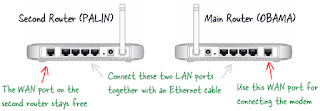What should you therefore do to ensure that the Wi-Fi signals are available in full strength in every corner of your house?
You can easily extend your Wi-Fi network with some additional hardware – like Wi-Fi repeaters and Wireless Access Points – but if you want to save a few bucks, just get hold of an old wireless router that you no longer use and connect it to your existing router using an inexpensive Ethernet cable.
Here's how I have setup the wireless network at my home using 2 routers connected with an Ethernet cable. I have is a main Wireless-N router connected to the ISP's modem. Then there's a second wireless router (Wireless-G) that is connected to the main router over an Ethernet or Cat-5 cable.
Use a Second Router as an Access Point
Let's call our main router MAIN (this is the router that is connected to the modem) and SlavE (the second router that you want to add to you existing network to increase your wireless range).
A: Note the Settings of the Main Router
Step 1: First we need to determine the IP address and the Subnet Mask of MAIN, our existing router.
Open the command prompt in Windows, run the command "ipconfig /all" and note the value of "Default Gateway." That your router's IP address. If you are on a Mac, open the Terminal window, type the command "route -n get default" and make a note of the gateway value.
For this example, let's assume your router's IP address is 192.168.30.1 and the Subnet Mask is 255.255.255.0.
Step 2: Open your web browser and type the router's IP address into the address bar. If you are using IE, you might want to add http:// to the address else IE may throw an error.
You'll now have to provide the user name and password for accessing the router settings. This will vary depending on your router's manufacturer – just Google for "<brand name> default router password" or try the standard combinations like admin/admin, admin/password and admin/<blank> (no password).
Step 3: Once you are inside the router settings, switch to Wireless Settings and make a note of the Wireless mode, the SSID and the channel.
If you have protected your Wi-Fi with a password, also note down the security mode used (WPA, WEP or WPA2) and your secret passphrase. Close the browser window.
B: Configure the Second Router
Step 4: Next we need to configure SlavE, our second router. First reset the router to factory defaults by hard-pressing the reset button for about 10 seconds.
Now connect the SlavE router to your computer using the Ethernet cable. Put one end of the cable in any of the LAN ports available on the router and the other end in your computer's Ethernet port. Make sure the router is powered on.
Step 5: Open the browser again and type 192.168.1.1 – the default internet IP address of your SlavE router. If you are not using a Linksys router, try 192.168.0.1 which is the default for Netgear and D-Link routers.
Once you are in the router settings, you need to change the values of the Wireless mode, the channel, the security mode and the passphrase such that they match with your MAIN router. You make use a different SSID name for this router.
Then go to Setup – > Advanced routing and change the current mode from Gateway to Router. Next disable DHCP Server since our main MAIN router will handle the task of assigning IP addresses to devices connecting to the wireless network.
Finally, change the IP address of the SlavE router to any free address in your LAN. For instance, if the IP address of MAIN router is 192.168.30.1, you can safely assign 192.168.30.2 to SlavE. Also make sure that the Subnet mask is the same as determined in Step 1. Save the router settings.
C: Connect the Two Routers with a Cat-5 Cable
Now that we have configured the routers, it's time to connect them with a physical Ethernet cable. Your main MAIN Router probably has five (1+4) ports – the WAN port (or the Internet port) should be connected to the ISP modems as before. Pick any of the available LAN ports on the router and connect it to any of the LAN ports on the SlavE router using an Ethernet cable. That's it.
Now that everything is setup, you can connect your computer and mobile devices to the second router using either a wired connection (the three ports are still free) or over Wi-Fi. Since everything is part of the same home network, all your shared folders, music libraries, photos, and other files will be accessible from all computers and mobile devices that are connected to the network.

0 comments :
Post a Comment
Thank you for feedback